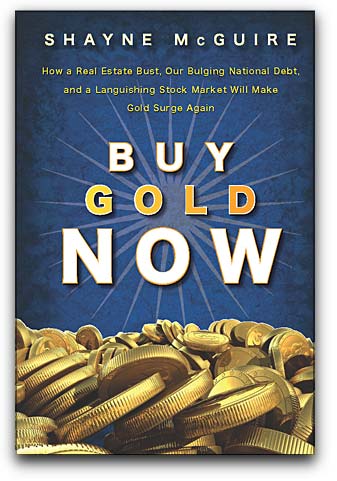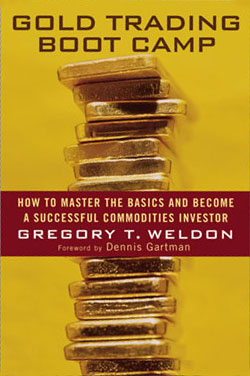Historically, September has been the best month for gold and the worst month for stocks. But in September 2018, gold posted a tiny loss of about 0.57%, closing the month at $1,195 per troy ounce; while the S&P 500 added an even tinier 0.43%. While gold was nominally lower and stocks nominally higher, you could basically say that both gold and U.S. stocks ended the month “unchanged.”
This should be good news for folks who aren’t yet as fully invested in gold as they would like to be. There’s good reason to believe that gold is trading near its long-term bottom, while stocks may reverse. And even if U.S. stocks continue their historic climb, gold may soon be on the rise anyway. There could be a gold rush in 2019, and the Federal Reserve – the ultimate enemies of gold – may be the inadvertent cause of it.
The Fed’s Effect on Gold
The Federal Reserve raised its benchmark interest-rate target to a range of 2% to 2.25% earlier this month. While the move was decried by President Trump, Fed officials indicated another hike is likely later this year.
Higher rates make the dollar stronger, and that can be bearish for gold, since gold is priced in U.S. dollars. Gold and the greenback have a historical correlation of around -80%, and higher interest rates also make non-yielding gold less attractive by comparison.
But lost in this line of theoretical reasoning is the empirical fact that gold prices surged throughout the high-rate 1970s, ultimately hitting $850 an ounce in January 1980. This was back when the Dow Jones Industrial Average was less than 1,000, too!
So gold can perform well in a high-rate environment. Indeed, while high interest rates can bolster a currency, higher rates are normally imposed by a central bank in an attempt to ward off inflation. Keep in mind that the dollar’s “strength” is measured against other fiat currencies, and virtually all central banks in the world are constantly inflating and debasing their currencies in an effort to boost their nation’s exports and lower their government’s sovereign-debt payments. The dollar can be “strong” compared to other fiat currencies, but still depreciating in purchasing power – and that will be bullish for gold.
And while the Fed seems intent on tightening at least one more time, bankers will probably be quick to reverse course when the economy weakens. U.S. economic data has been very bullish lately, justifying the Fed’s hikes, but there are numerous warning signs – including a persistently flat yield curve – that a recession might not be so far away. If the Fed were to blink, indicating further accommodation for the stock market, gold prices could really take off.
How to Gain Exposure to Gold
The best way to invest in gold is to buy physical gold bullion and keep it in your home. This isn’t always practical, for a variety of reasons, so investors should also be aware of ways they can gain exposure to gold in their brokerage accounts.
Furthermore, some means of gaining exposure to gold – such as goldmining stocks – offer more leverage, which means the investments should outperform gold itself if gold rallies. By the same token, this means the investments are more likely to lose more than gold in a down market, of course.
The four means of gaining gold exposure we’ll explore are:
- Commodity ETFs
- Goldminer ETFs
- Mutual funds
- Closed-end funds
We’ll look at a few of the best options within each group, for a total of ten:
Commodity ETFs
GLD is the most popular gold commodity ETF. It has been operating since 2004, and it currently has $29 billion in assets. One share of GLD is roughly equivalent to 1/10 troy ounce of gold. The GLD exchange-traded fund closed September at $112.67 per share, compared to gold’s price of $1,195 per ounce.
GLD may not be as good as gold, but it is easier to buy and sell on a stock exchange. One negative is that GLD has an expense ratio, like almost all ETFs, while physical gold obviously does not. GLD’s 0.4% expense ratio eats away at its annual returns, which stood at -8.6% as of September 21, compared to gold’s losses of less than 8%.
The good news is that GLD isn’t the only gold commodity ETF trading today. The iShares Gold Trust (ticker: IAU) is a newer and smaller fund, but its lower 0.25% expense ratio helped it outperform GLD for the 52 weeks ending September 21, 2018. While GLD returned -8.6% over that time period, IAU performed a little better at -8.5%.
Both GLD and IAU offer investors quick and easy access to gold in their brokerage accounts at reasonable fees. They aren’t a preferable substitute for physical gold, which outperformed both by nearly 1 percentage point during the time period under review, but they entail no storage costs and are at less risk to be stolen by burglars (if you consider that a serious risk).
Goldminer ETFs
Individual goldminer stocks carry idiosyncratic risks specific to each company. While it’s certainly possible to hit a huge homerun with an individual mining stock, you could also strike out and fall flat on your face – even if gold rises. For this reason, it may be wise to hedge your bets across a variety of goldminers by investing in a goldminer exchange-traded fund (“ETF”).
The two most popular goldminer ETFs are GDX and GDXJ, both of which are operated by VanEck Vectors. GDX’s focus is on the largest companies in the goldmining industry, while GDXJ is the ETF for the relatively “minor” miners, also known as “juniors” – i.e., small-cap goldmining stocks.
Both GDX and GDXJ lost a ton of ground in the 52 weeks ending September 21, 2018: GDX fell 20.8%, while GDXJ sunk by 18.9%. But over the longer haul, GDXJ has been the underperformer, losing a whopping 84% of its value since its peak in 2011, while GDX has lost “only” 70% since its peak that same year.
Goldmining stocks (and the ETFs that hold them) offer investors a leveraged play on gold. When gold prices are rising, the share prices of goldmining stocks tend to rise even faster. Obviously, the reverse is true, too, which is why both GDX and GDXJ have lost so much ground since gold apexed and reversed in 2011. But if gold is poised for a turnaround, GDX and GDXJ are likely to post even bigger gains than gold itself.
If you do want to venture into the choppier waters of holding individual goldminer stocks, some to consider are Newmont Mining (NEM), Barrick Gold (ABX), and Franco-Nevada (FNV), which are three of GDX’s largest holdings. GDXJ’s largest holding, Northern Star Resources, is a pink sheet stock.
Gold-Themed Mutual Funds
Gold-themed mutual funds are another option. Three of the most interesting are:
- The Fidelity Select Gold Portfolio Fund (FSAGX);
- The First Eagle Gold Fund (SGGDX); and
- The VanEck International Investors Gold Fund (INIVX).
The Fidelity Select Gold Portfolio Fund has a three-star rating from Morningstar. It has $1.1 billion in assets under management, and its largest holdings include the goldmining stocks Newmont Mining and Agnico Eagle Mines (AEM). The fund has a 0.84% expense ratio and no minimum investment.
The First Eagle Gold Fund has a four-star rating from Morningstar. It has a little less than $900 million in assets under management, and its largest holdings are physical gold and silver, as well as Royal Gold (RGLD) and the pink-sheet Newcrest Mining. The fund has a 1.26% expense ratio, and a $2500 minimum investment.
Finally, the VanEck International Investors Gold Fund. It has a three-star Morningstar rating and about $570 million in assets under management. The fund is underweighted in the largest miners and has a focus in smaller, more speculative firms. It has a 1.43% expense ratio and a $1000 minimum investment. Kirkland Lake Gold (KL) and B2Gold (BTG) are its two largest holdings.
Since gold hasn’t performed well over the past couple of years, it shouldn’t be surprising that all three of these mutual funds have negative returns for the 52 weeks ending September 21, 2018. Fidelity’s fund lost 23.6% over that time, while the First Eagle and VanEck funds posted respective losses of 24.4% and 21%. Clearly, these funds have lagged the stock market in performance, but there is an argument to be made that they’re oversold and due to rebound.
Closed-End Funds
Closed-end funds are similar to mutual funds, except they each have a fixed number of shares, and those shares aren’t redeemable with the company. In this way, they’re a lot like ETFs, too.
Three gold-themed closed-end funds worth consideration are:
- The ASA Gold and Precious Metals Fund (ASA);
- The Sprott Physical Gold & Silver Trust (CEF); and
- The Sprott Physical Gold Trust (PHYS).
While the value of mutual funds are based strictly on the value of their underlying holdings, it’s possible for closed-end funds to trade at a premium or discount to their net-asset value. The ASA Gold and Precious Metals Fund traded at a 13% discount to the value of its underlying assets, as of September 28, 2018.The Sprott trusts also traded at discounts, but substantially smaller ones of 4% and 1.7%, respectively.
The ASA fund owns mostly goldmining stocks. Its top holdings include Randgold Resources (GOLD), Newmont Mining, and Agnico Eagle Mines. By buying the fund, you get access to these stocks (and more), but at a significant discount to their current share prices.
The Sprott Physical Gold & Silver Trust holds 2/3 of its assets in gold, and the remaining 1/3 in silver. The Sprott Physical Gold Trust is entirely gold-based. And unlike most other precious-metals funds, the Sprott trusts allow holders to take physical delivery of their underlying gold and silver if they so choose. Although these funds are trading at a lower discount to their net-asset value than the ASA fund, getting exposure to physical gold and silver – with the option of taking delivery – at a discount to the spot price is an attractive proposition.
Recap & Summary
To review, here are the 10 ways of joining what could be a gold rush coming in 2019 (if not before):
- SPDR Gold Shares ETF (GLD)
- iShares Gold Trust ETF (IAU)
- VanEck Vectors Goldminers ETF (GDX)
- VanEck Vectors Junior Goldminers ETF (GDXJ)
- Fidelity Select Gold Portfolio mutual fund (FSAGX)
- First Eagle Gold mutual fund (SGGDX)
- VanEck International Investors Gold mutual fund (INIVX)
- ASA Gold and Precious Metals closed-end fund (ASA)
- Sprott Physical Gold & Silver Trust closed-end fund (CEF)
- Sprott Physical Gold Trust closed-end fund (PHYS)
This is not a ranked list, and Silver Monthly doesn’t necessarily endorse any of these funds. Do your own research! But if you’re looking to gain portfolio exposure to the next bull market in gold, one or more of these ten funds – or perhaps one (or more) of the individual stocks mentioned in the article – could be the right play for you.


